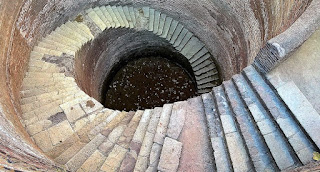Helical Stepwell
Helical stepwells, also known as Baoli stepwells or Vav stepwells, are unique architectural structures found in India. They are notable for their spiral or helical staircase design that descends around the well shaft. These stepwells were primarily built to provide water storage, irrigation, and a place for the community to gather and socialize.
The history of helical stepwells can be traced back to ancient times, with the earliest examples dating as far back as the 2nd century CE. They reached their peak of construction and popularity between the 10th and 16th centuries during the era of medieval India. Many of these stepwells were constructed in regions with arid climates, where water conservation and management were crucial.
The design of helical stepwells typically consists of a series of steps that lead down to the water level. The steps are arranged in a helical or spiral formation, often in a circular or rectangular shape. The well shaft is located at the center, and the steps are constructed along the inner walls, allowing access to the water source at various levels.
In addition to their utilitarian purpose of water storage and distribution, helical stepwells were also important cultural and architectural landmarks. They were places of community gatherings, religious ceremonies, and social interactions. The intricate carvings, sculptures, and architectural features found in these stepwells reflected the artistic and architectural sensibilities of the time.
Over the centuries, many helical stepwells fell into disuse and disrepair due to changing water management systems and shifts in societal needs. However, efforts have been made to preserve and restore these architectural marvels. Several helical stepwells, such as the Adalaj Stepwell in Gujarat and the Rani ki Vav in Patan, Gujarat (a UNESCO World Heritage Site), have gained recognition for their historical significance and have become popular tourist attractions.
Helical stepwells serve as a testament to the ingenuity and architectural prowess of ancient Indian civilizations. They stand as fascinating examples of how communities managed and conserved water while also creating visually stunning structures that blended functionality with artistry.
How To Get There :-
By Road :- Champaner is 45 km from Vadodara, accessible by bus or private vehicles. Cars can be hired in Vadodara to drive to Champaner-Pavagadh, which is the best option if you want to combine the journey with other sites like Jambughoda.



0 Comments